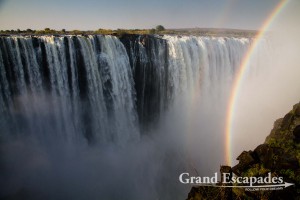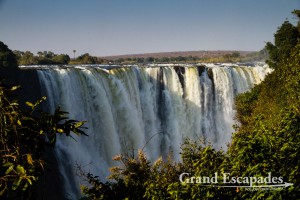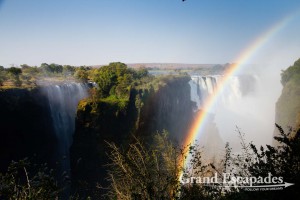“Scenes so lovely must have been gazed upon by angels in their flight”, Livingstone is quoted saying when he first set eye on what the local Makololo people called “The Smoke That Thunders”. Could he really guess in 1855 that one day thundering helicopters would take tourists high up in the sky to get that angel’s view? Livingstone, who was taken there in a dugout canoe, was lucky to arrive in November. During peak flow from March to May, the falls are completely obscured by the massive spray.
In July, when we visited, it was still going so strong that soon we were completely wet, freezing and shivering. Even worse, at some view points taking photos was simply out of question, unless you had an underwater camera. Only the thundering noise gave the falls away. Quite different to what it must look like in November. Then the falls are reduced to a mere trickle disappearing in the 108 meter deep narrow gorge. This makes it biggest waterfalls on this planet. It’s not only deep but also narrow as the photos Gilles took from the helicopter revealed, thus explaining the tremendous spray. These chilly showers and the reduced photo options lessened our disappointment that we would not be back for sunrise. There was no way we would pay 35 USD again. Yes, for this kind of money you get only a single entry ticket!
None of the activities around here is cheap, but nobody comes to Zimbabwe without seeing the Falls. Even during the darkest times tourists kept coming, zipping across the bridge from Zambia. Some probably never realized they were in a different country, with the village of Victory Falls being a good mile up the road…




No comments yet.